Zara (retailer)
|
| |
| Sociedad Anónima | |
| Industry | Retail |
| Founded | 1975 (as Zorba) |
| Founders |
Amancio Ortega Rosalía Mera |
| Headquarters | Arteixo (A Coruña), Spain |
Number of locations | 7,475 stores[1] |
Area served | Worldwide |
| Products | Clothing |
| Revenue | US$9 billion annually (2016)[2] |
| Parent | Inditex |
| Website |
zara |
Zara SA (Spanish: [ˈθaɾa]) is a Spanish fast fashion[3] (clothing and accessories) retailer based in Arteixo (A Coruña) in Galicia. The company was founded in 1975 by Amancio Ortega and Rosalía Mera. It is the main brand of the Inditex group,[4] the world's largest apparel retailer. The fashion group also owns brands such as Massimo Dutti, Pull&Bear, Bershka, Stradivarius, Oysho, Zara Home, and Uterqüe. Zara as of 2017 manages up to 20 clothing collections a year.[5]
History
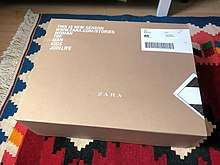
Early history
Amancio Ortega opened the first Zara store in 1975 in central A Coruña, Galicia, Spain. Ortega initially named the store Zorba after the classic film Zorba the Greek, but after learning there was a bar with the same name two blocks away, they rearranged the letters molded for the sign to "Zara". It is believed the extra "a" came from an additional set of letters that had been made for the company.[6][7] The first store featured low-priced lookalike products of popular, higher-end clothing fashions. Ortega opened additional stores throughout Spain. During the 1980s, Ortega changed the design, manufacturing, and distribution process to reduce lead times and react to new trends in a quicker way, which he called "instant fashions". The improvements included the use of information technologies and using groups of designers instead of individuals.
Expansion
In 1988, the company started its international expansion through Porto, Portugal.[8] In 1989, it entered the United States, and then France in 1990.[9] During the 1990s, Zara expanded to Mexico (1992),[10] Greece, Belgium and Sweden (1993). In the early 2000s, Zara opened its first stores in Japan and Singapore (2002), Russia and Malaysia (2003),[11][12][13] China,[14] Morocco,[15] Estonia,[16] Hungary[17] and Romania (2004),[18] the Philippines,[12] Costa Rica[19] and Indonesia (2005),[20] South Korea (2008),[21] India (2010),[22] and South Africa and Australia (2011).[23][24]
On September 2010, Zara launched its online boutique. The website began in Spain, the UK, Portugal, Italy, Germany and France.[25] In November that same year, Zara Online extended the service to five more countries: Austria, Ireland, the Netherlands, Belgium and Luxembourg.[26] Online stores began operating in the United States in 2011,[27] Russia and Canada in 2013,[28][29][30] and Mexico,[31] Romania,[32] and South Korea in 2014.[33][34] India in 4 October 2017.
Zara introduced the use of RFID technology in its stores in 2014. The RFID chips are located in the security tags which are removed from clothing when it is purchased and can be reused. The chip allows the company to quickly take inventory by detecting radio signals from the RFID tags. When an item is sold, the stockroom is immediately notified so that the item can be replaced. An item that is not on the shelf can easily be found with the RFID tag.[35]
In 2015, Zara was ranked 30 on Interbrand's list of best global brands.[36]
Products
Zara stores have men's and women's clothing, as well as children's clothing (Zara Kids). Zara's products are supplied based on consumer trends. Its highly responsive supply chain ships new products to stores twice a week. After products are designed, they take ten to fifteen days to reach the stores.[37] All of the clothing is processed through the distribution center in Spain. New items are inspected, sorted, tagged, and loaded into trucks. In most cases, the clothing is delivered within 48 hours. Zara produces over 450 million items per year.[38]
Manufacturing and distribution
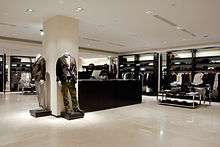
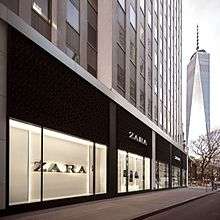
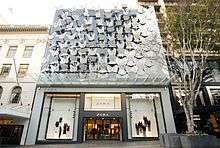
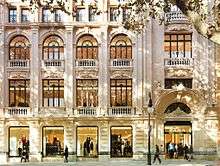
Reportedly, Zara needs just one week to develop a new product and get it to stores, compared to the six-month industry average, and launches around 12,000 new designs each year.[39] Zara has a policy of zero advertising;[6] the company preferred to invest a percentage of revenues in opening new stores instead.[40]
Zara set up its own factory in La Coruña (a city known for its textile industry) in 1980, and upgraded to reverse milk-run-type production and distribution facilities in 1990. This approach, designed by Toyota Motor Corp., was called the just-in-time (JIT) system. It enabled the company to establish a business model that allows self-containment throughout the stages of materials, manufacture, product completion and distribution to stores worldwide within just a few days.[41]
Most of the products Zara sells are manufactured in proximity countries like Spain, Portugal, Turkey and Morocco.[6][42] While some competitors outsource all production to Asia, Zara manufactures its most fashionable items—half of all its merchandise—at a dozen company-owned factories in Spain and Portugal and Turkey, particularly in Galicia and northern Portugal and Turkey. Clothes with a longer shelf life, such as basic T-shirts, are outsourced to low-cost suppliers, mainly in Asia.[43]
The company can design a new product and have finished goods in its stores in four to five weeks; it can modify existing items in as little as two weeks. Shortening the product life cycle means greater success in meeting consumer preferences.[44] If a design does not sell well within a week, it is withdrawn from shops, further orders are canceled and a new design is pursued. Zara monitors customers' fashion changes.[45] Zara has a range of basic designs that are carried over from year to year, but some fashion forward designs can stay on the shelves less than four weeks, which encourages Zara fans to make repeat visits. An average high-street store in Spain expects customers to visit three times a year. That goes up to 17 times for Zara.[46]
As a result of increasing competitive pressures from the online shopping market, Zara is shifting its focus onto online as well, and will consequently open fewer but larger stores in the future.[47]
Non-toxic clothing
In 2011, Greenpeace started a dialog with Zara to ban toxics from the clothing production.[48] Greenpeace published its "Toxic threads: the big fashion stitch-up" report in November 2012 as part of its Detox Campaign identifying companies that use toxic substances in their manufacturing processes.[49] Nine days after the report was published, Zara committed to eradicating all releases of hazardous chemicals throughout its entire supply chain and products by 2020.[50] Zara became the biggest retailer in the world to raise awareness for the Detox Campaign,[51] and switched to a fully toxic-free production.[48]
Exploitation and child labour
In 2016, BBC News stated that they found evidence for child labour and exploitation in factories in Turkey. Zara replied that there were some issues in June 2016 in one single factory and - instead of solving these 'issues' immediately -, they have given a period of six months to solve them.[52]
Controversy
In 2007, Zara withdrew a handbag from their shelves after a customer noticed a swastika on the bag's design. The bag came from an external supplier, and Zara said that the symbol was not visible when the handbag was chosen. Zara spokesman Susan Suett said that if they had noticed the handbag featured the symbol, they would not have sourced it. Once informed of the swastika symbol, they immediately withdrew the item from their shelves.[53]
In 2009, there was an email rumor claiming that Zara "has been openly anti-Semitic for a long time" and contained a picture of the handbag that featured a swastika symbol in 2007. The Anti-Defamation League addressed the email and said that Zara is not anti-semitic and the incident involving the bag was remedied by removing the bag from their shelves. The handbag was produced by an India-based supplier, and the swastika is a religious symbol for Hindus and Buddhists that represents the sun, strength, and good luck, as well as similar applications worldwide in various cultures far removed from systemized abuse.[54]
In August 2011, a Brazilian television show accused the company of using suppliers who were running sweatshops for their outsourced production. The Regional Superintendency of Labour and Employment of São Paulo, Brazil, closed a factory that produced Zara's clothing for its poor labour conditions.[55] Zara’s representatives said that the accusations of slave labour made against the retailer represent a breach of the code of conduct for workshops of Inditex. The company also states that all factories responsible for unauthorized outsourcing have been asked to regularize immediately the situation of the workers involved.[56]
In August 2014, Zara received criticism for selling a toddler T-shirt for closely resembling uniforms worn by Jewish concentration-camp inmates. The T-shirt was striped and featured a yellow star similar to the Star of David. Zara said that the design of the shirt was inspired by "the sheriff's stars from the classic western films". After being on sale for a few hours, Zara immediately removed the shirt and apologized.[57] Zara received heavy criticism for selling the T-shirt in Israel because Israel does not have sheriffs. Additionally, the word "Sheriff" is outlined in transparent letters on the bright yellow star.[57] The Anti-Defamation League responded to the shirt, saying that it was offensive, but welcomed Zara's recognition of the potential imagery and removing the shirt from sale.[58]
In July 2016, complaints were made against Zara that they had been stealing designs from multiple independent designers for their products. One of the designers, Tuesday Bassen, who previously worked with brands including Urban Outfitters and Nike, contacted Zara and received a response from Zara that claimed that Bassen's designs were not distinctive enough, and that they received only a handful of complaints given the large volume of traffic they receive on their site. When the news was eventually picked up by media outlets, and Inditex, Zara's owning company, was asked to comment on the issue, Inditex replied that the items in question have been suspended from sale, and that they are in contact with Bassen's lawyer to clarify and address the issue.[59][60]
In November 2017, customers shopping at Zara stores in Istanbul, Turkey, found handwritten notes purportedly from Turkish workers in the pockets of in-store garments asking shoppers to pressure Zara into paying them the wages, which they claim they are owed.[61]
As of January 2018, Chinese authorities are publicly scolding Zara for listing Taiwan as a country on their website.[62]
As of April 2018, MaXhosa by Laduma is taking legal action against Zara for copying its designs.[63]
In June 2018, a Zara jacket with "I really don't care, do U?" emblazoned on the back became controversial after it was worn by Melania Trump when she visited a camp for migrant children separated from their parents.[64]
Stores
There are over 2,200 Zara stores located across 96 markets.[65][66]
See also
References
- ↑ https://static.inditex.com/annual_report_2017/en/main-indicators. Missing or empty
|title=(help) - ↑ "Zara on the Forbes World's Most Valuable Brands List". forbes.com. Retrieved 13 March 2018.
- ↑ "Zara is facing a massive threat that could jeopardize the business". businessinsider.de. Retrieved 13 March 2018.
- ↑ "Global stretch". The Economist. 10 March 2011. Retrieved 5 November 2015.
- ↑ "Looking good can be extremely bad for the planet". The Economist. Retrieved 16 April 2017.
- 1 2 3 Hansen, Suzy (9 November 2012). "How Zara Grew Into the World's Largest Fashion Retailer". The New York Times. p. 2.
- ↑ How Zara became the world's biggest fashion retailer. Graham Ruddick. 20 October 2014. Telegraph. accessed 5 April 2016.
- ↑ "Spanish domination - Zara brand profile - Marketing Magazine". marketingmag.com.au. Retrieved 13 March 2018.
- ↑ "Why high street giant Zara always gets it right". Irish Independent. 29 October 2015.
- ↑ "Fashion invasion". The Economist. 8 December 2012. Retrieved 8 April 2016.
- ↑ Kreknina, Aleksandra (25 October 2012). "Zara plans to open over 50 shops in Russia every year". Russia Beyond The Headlines. Retrieved 8 April 2016.
- 1 2 John Dawson; Roy Larke; Masao Mukoyama (21 August 2006). Strategic Issues in International Retailing. Routledge.
|access-date=requires|url=(help) - ↑ Robert D. Hisrich; Claudine Kearney (25 June 2013). Managing Innovation and Entrepreneurship. Sage Publications.
- ↑ "Zara takes a cautious step into China". Just-Style. 6 September 2004. Retrieved 8 April 2016.
- ↑ Robb Young (5 November 2013). "In North Africa, a Story of Morocco and the Rest". Business of Fashion. Retrieved 8 April 2016.
- ↑ "Zara opens in the Baltic republics by opening a store in Estonia". El Pais. 17 August 2004. Retrieved 8 April 2016.
- ↑ "Milestones in Hungary's fashion life". Property Magazine. 11 October 2012. Retrieved 8 April 2016.
- ↑ "Zara launches online shop in Romania". Romania Insider. 1 April 2014. Retrieved 8 April 2016.
- ↑ "Zara Opens in Costa Rica". Inside Costa Rica. 16 May 2005. Retrieved 8 April 2016.
- ↑ "Mitra Adiperkasa offers everything, from Zara to Starbucks". The Jakarta Post. 24 April 2005. Archived from the original on 20 June 2014. Retrieved 8 April 2016.
- ↑ "Spains Zara Opens First Store in Korea". The Korea Times. 29 April 2008. Retrieved 8 April 2016.
- ↑ "Fashion chain Zara opens its first Indian store". BBC. 31 May 2010. Retrieved 8 April 2016.
- ↑ Emma Jordan (19 January 2011). "Zara to Open in South Africa". iFashion. Retrieved 8 April 2016.
- ↑ "Global phenomenon Zara finally opens in Sydney". Vogue. 19 April 2011. Retrieved 8 April 2016.
- ↑ "Zara launches online boutique". fashionunited.com. 6 September 2010. Retrieved 22 June 2014.
- ↑ "Zara.com launches in 5 more countries". Retrieved 30 May 2015.
- ↑ "Inditex post record profits". Retrieved 30 May 2015.
- ↑ "Zara's Secret To Success: The New Science Of Retailing". Forbes. 14 October 2013. Retrieved 29 April 2016.
- ↑ Mary Kim (12 February 2013). "Zara To Launch Canadian Online Story". The Huffington Post. Retrieved 29 April 2016.
- ↑ Michelle Reddick (5 March 2013). "Zara launches online shopping in Canada". Toronto Life. Retrieved 29 April 2016.
- ↑ Katie Evans (10 September 2014). "Zara sells online in Mexico". Internet Retailer. Retrieved 29 April 2016.
- ↑ "Zara launches online store in Romania". Ecommerce News. 28 March 2014. Retrieved 29 April 2016.
- ↑ "Zara launches online in South Korea". Inside Retail. 7 October 2014. Retrieved 29 April 2016.
- ↑ "Inditex: Zara to launch online platforms in South Korea and Mexico". Evigo. 12 December 2013. Retrieved 29 April 2016.
- ↑ Bjork, Christopher (16 September 2014). "Zara Builds Its Business Around RFID". The Wall Street Journal. Retrieved 29 April 2016.
- ↑ "Zara". Interbrand. Retrieved 9 June 2016.
- ↑ The Future of Fashion Retailing: The Zara Approach 25 October 2012. Greg Petro. Forbes. accessed 5 April 2016
- ↑ Zara's Fast-Fashion Edge. Susan Berfield and Manuel Baigorri. 14 November 2013. Bloomberg. accessed 5 April 2016
- ↑ Burgen, Stephen. "Fashion chain Zara helps Inditex lift first quarter profits by 30%``". The Guardian. The Guardian. Retrieved 12 January 2015.
- ↑ Zara's Big Idea: What the World's Top Fashion Retailer Tells Us About Innovation. Derek Thompson. 13 November 2012. The Atlantic. accessed 5 April 2016
- ↑ Kojima, Kensuke (2011). Uniqlo Syndrome. Japan: Tenkai. ISBN 4-492-76191-8.
- ↑ The 5 ingredients of Zara's success. Bibby Sowray. 11 December 2015. Telegraph. accessed 5 April 2016
- ↑ Fashion Conquistador Businessweek
- ↑ Executive Masters in International Logistics at Georgia Tech
- ↑ Friedman, Thomas (2006). The World is Flat. New York: Farrar, Straus, and Giroux. p. 154. ISBN 978-0-374-29279-9.
- ↑ Roux, Caroline (28 October 2002). "The reign of Spain". The Guardian. Retrieved 22 June 2014.
- ↑ "Even Zara Can Have a Wardrobe Malfunction". Bloomberg.com. 14 March 2018. Retrieved 14 March 2018.
- 1 2 "People! Zara commits to go toxic-free". Greenpeace.org. 29 November 2012.
- ↑ "Toxic threads: the big fashion stitch-up" (PDF). Greenpeace.org. 20 November 2012. pp. 15, 24.
- ↑ Alice Newbold (1 December 2012). "Zara Just Caved To Greenpeace And Agreed To Stop Using Toxic Chemicals". Business Insider. Retrieved 29 April 2016.
- ↑ "Greenpeace voert actie bij Zara tegen giftige kleding". De Morgen (in Dutch). 24 November 2012. Archived from the original on 30 October 2013.
- ↑ https://www.bbc.com/news/business-37716463
- ↑ "Zara withdraws swastika handbags". BBC.co.uk. British Broadcasting Corporation. 19 September 2007. Retrieved 25 April 2015.
- ↑ "Spanish Fashion Store Zara Not 'Anti-Semetic'". ADL.org. Anti-Defamation League. 30 September 2009. Retrieved 25 April 2015.
- ↑ Guerra, Carolina (17 August 2011). "Marca Zara está envolvida em denúncia de trabalho escravo". VEJA (in Portuguese). Retrieved 22 June 2014.
- ↑ Antunes, Anderson (17 August 2011). "Zara Accused Of Alleged 'Slave Labor' In Brazil". Forbes.
- 1 2 Kaufman, Alexander (27 August 2014). "Zara Apologizes for Pajamas That Look Just Like A Concentration Camp Uniform". The Huffington Post. Retrieved 25 April 2015.
- ↑ Grinberg, Emanuella (28 August 2014). "Retailer pulls shirts reminiscent of Holocaust". CNN.com. Cable News Network. Retrieved 25 April 2015.
- ↑ Davies, Madeleine. "Zara Copies Indie Artist's Work, Then Says She's Not Famous Enough For It to Matter". jezebel.com. Retrieved 13 March 2018.
- ↑ Addady, Michal (20 July 2016). "12 Artists Are Accusing Zara of Stealing Their Designs". Fortune. Retrieved 4 October 2017.
- ↑ Young, Sarah (5 November 2017). "Unpaid laborers are 'slipping pleas for help into Zara clothes". The Independent. Retrieved 5 November 2017.
- ↑ "Delta flies into China trouble over Tibet and Taiwan". 12 January 2018.
- ↑ Matangira, Lungelo. "Maxhosa's Laduma on Zara design knock-offs: It's shocking & lacks integrity". Retrieved 2018-04-25.
- ↑ Heil, Emily (21 June 2018). "How Melania Trump's jacket choice overtook her visit to the Texas border shelters". The Washington Post. Retrieved 7 July 2018.
- ↑ How Zara became the world's biggest fashion retailer. 20 October 2014. Graham Ruddick. accessed 5 April 2016
- ↑ Zara new season styles: what to buy at the Spanish giant right now. Linda Sharkey. 29 May 2015. Independent. accessed 5 April 2016
External links
- Official website


